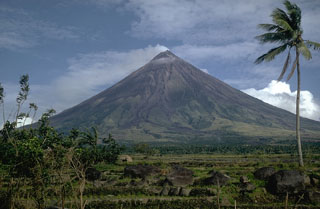Report on Mayon (Philippines) — 30 August-5 September 2006
Smithsonian Institution / US Geological Survey
Weekly Volcanic Activity Report, 30 August-5 September 2006
Managing Editor: Sally Sennert.
Please cite this report as:
Global Volcanism Program, 2006. Report on Mayon (Philippines) (Sennert, S, ed.). Weekly Volcanic Activity Report, 30 August-5 September 2006. Smithsonian Institution and US Geological Survey.
Mayon
Philippines
13.257°N, 123.685°E; summit elev. 2462 m
All times are local (unless otherwise noted)
Occasional explosions at Mayon continued during 30 August-5 September. According to seismic data, four explosions were registered on 31 August. Ashfall was reported in surrounding cities including Tabaco (about 13 km NW) and Guinobatan (about 13 km SW). One small explosion was registered on 3 September. Lava extrusion and collapsing lava-flow fronts on the SE slopes continued to produce blocks and small fragments during the reporting period.
Geological Summary. Symmetrical Mayon, which rises above the Albay Gulf NW of Legazpi City, is the most active volcano of the Philippines. The steep upper slopes are capped by a small summit crater. Recorded eruptions since 1616 CE range from Strombolian to basaltic Plinian, with cyclical activity beginning with basaltic eruptions, followed by longer periods of andesitic lava flows. Eruptions occur predominately from the central conduit and have also produced lava flows that travel far down the flanks. Pyroclastic density currents and mudflows have commonly swept down many of the approximately 40 ravines that radiate from the summit and have often damaged populated lowland areas. A violent eruption in 1814 killed more than 1,200 people and devastated several towns.
Sources: Philippine Institute of Volcanology and Seismology (PHIVOLCS), The Daily Tribune, Inquirer.net

